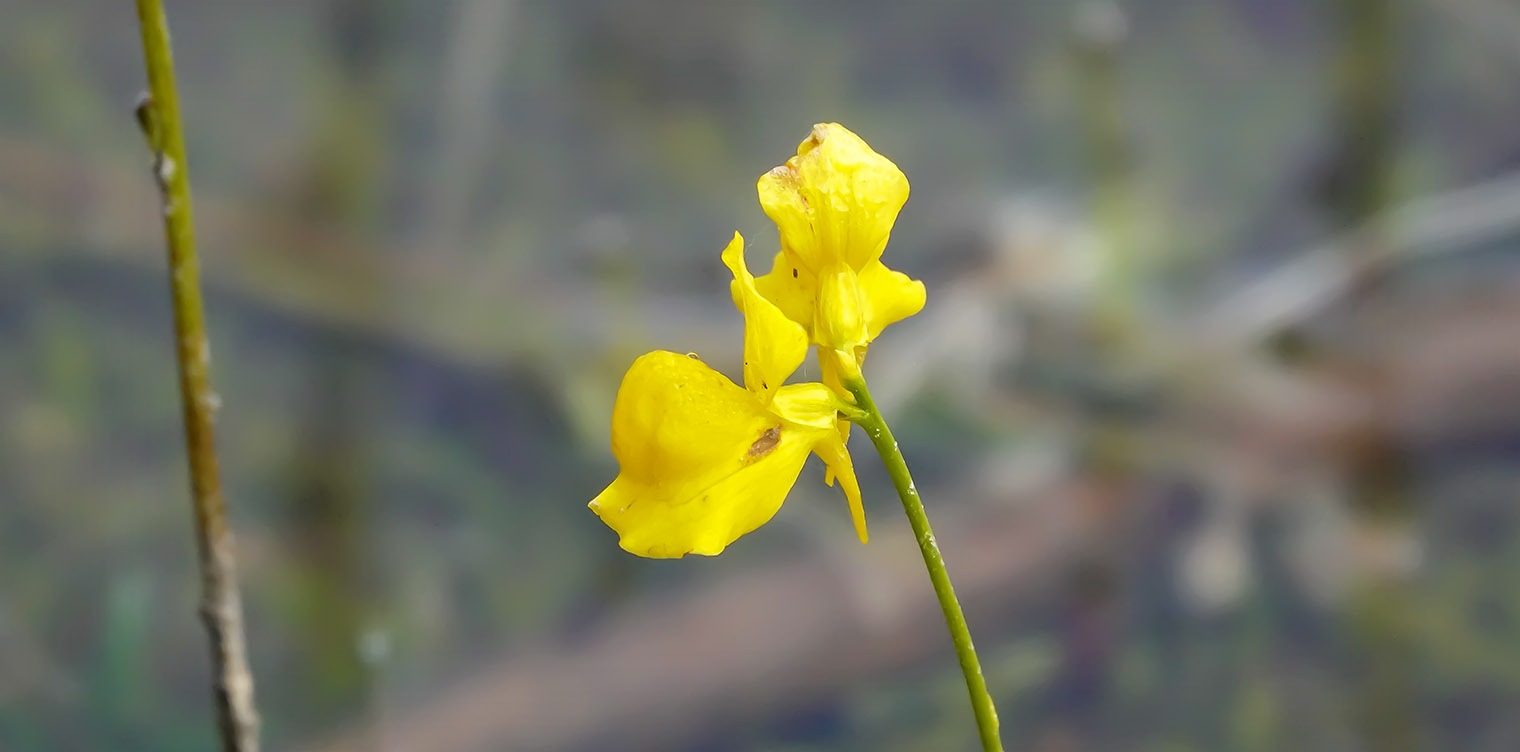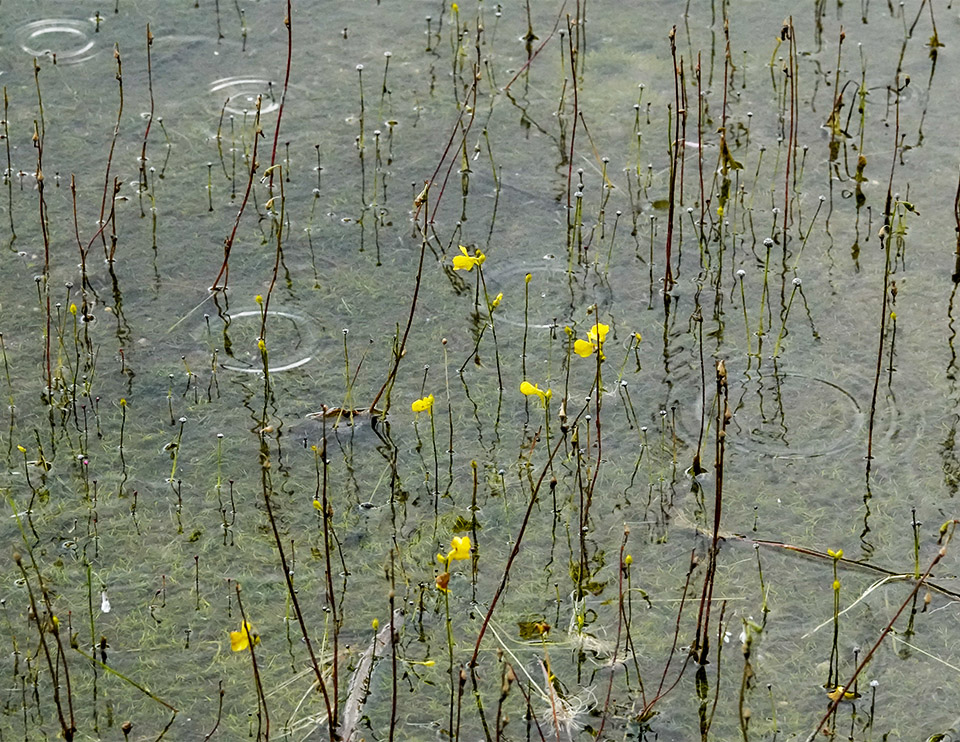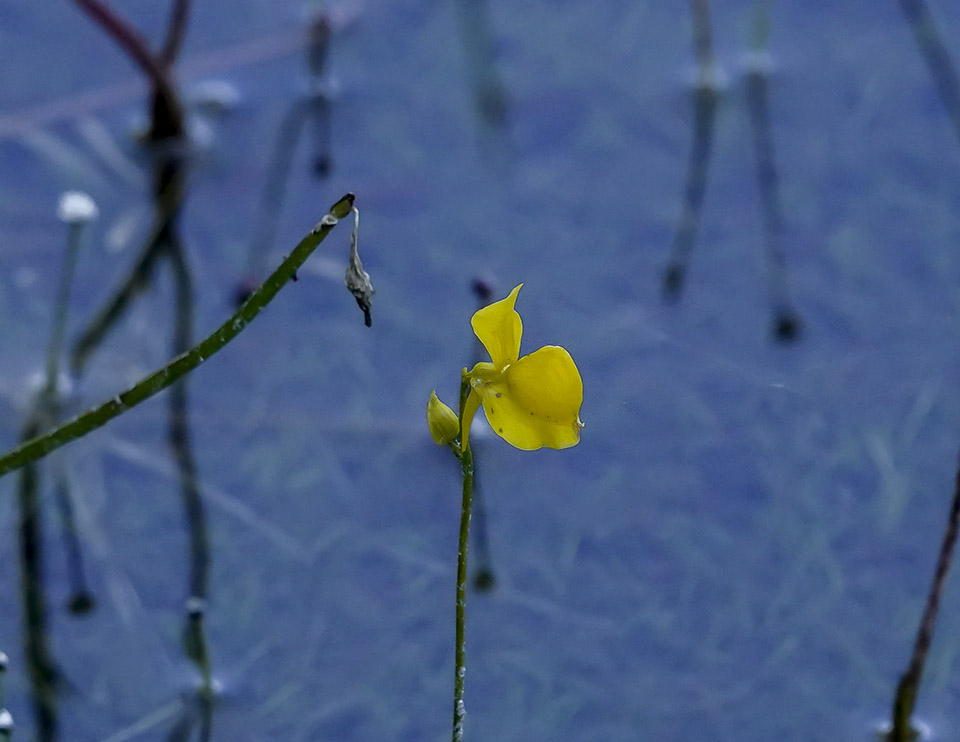Wildflowers of the Adirondacks:
Horned Bladderwort (Utricularia cornuta)

Horned Bladderwort (Utricularia cornuta) is a carnivorous plant found in bogs and along the shorelines of ponds and lakes in the Adirondacks.
Horned Bladderwort is one of ten species in the Utricularia (bladderwort) genus that occur in the Adirondacks. The others are:
- Flat-leaved Bladderwort (Utricularia intermedia)
- Greater Bladderwort (Utricularia vulgaris)
- Hidden-fruited Bladderwort (Utricularia geminiscapa)
- Humped Bladderwort (Utricularia gibba)
- Lesser Bladderwort (Utricularia minor)
- Purple Bladderwort (Utricularia purpurea)
- Reclined Bladderwort (Utricularia resupinata)
- Rush Bladderwort (Utricularia juncea)
- Small Swollen Bladderwort (Utricularia radiata)
The nonscientific name of this genus (Bladderwort) is a reference to the fact that these plants have specialized bladders to trap and digest small invertebrates. The species name (cornuta) is a reference to the long spur on the flower, which also accounts for the nonscientific name of this particular species: Horned Bladderwort.
Identification of Horned Bladderwort

Horned Bladderwort is an erect, carnivorous plant that feeds on small invertebrates. It captures its prey with the aid of small bladders which are submersed in shallow water or wet soil.
- The bladders are about ¼ inch across. Each bladder has a trap door surrounded by trigger hairs.
- When the prey, apparently mistaking the hairs for food, disturbs the hairs, the trap door opens, sucking the animal inside, where it is digested, providing the plant with nitrogen.
- The bladderwort's prey items include minute crustaceans, such as fairy shrimps and water fleas, as well as paramecia, such as rotifers and microscopic insect larvae.
The flower of Horned Bladderwort consists of one to six bright yellow blooms, each about ½ to ¾ inch long. The flowers, which appear on top of a slender, brownish stalk, have two lips. The lower lip is large and helmet shaped with a conspicuous long, drooping spur that projects downward. In the Adirondacks, Horned Bladderwort blooms in July and August.
The fruit of Horned Bladderwort is a tiny capsule, which splits open when ripe.
Uses of Horned Bladderwort
No edible or medicinal uses for Horned Bladderwort could be found.
Wildlife Value of Horned Bladderwort

Horned Bladderwort has limited wildlife value. The species is not a preferred food of any species. Bladderworts are consumed occasionally by ducks, such as Hooded Mergansers. The stem reportedly has minor value as a food source for Muskrats. Moose and White-trailed Deer are also said to eat this plant, but it represents a very minor part of their diet. Snapping Turtles also feed on the plants, as do some aphids. The plant is reportedly used for shelter by small tadpoles and fishes.
Distribution of Horned Bladderwort
Horned Bladderwort plants are widely distributed on the North American continent. This species is found from Alberta east to Newfoundland, south to Florida, west to Texas, and north to Arkansas, Illinois, Wisconsin, and Minnesota. This plant is categorized as endangered in Illinois and Ohio, threatened in Indiana, and a plant of special concern in Tennessee.
In New York State, Horned Bladderwort occurs mainly in the northern and eastern parts of the state. In the Adirondack Park, this species grows in all counties except Washington County.
Habitat of Horned Bladderwort

Horned Bladderwort is classified as an obligate wetland plant (OBL), meaning that it almost always occurs in wetlands. It grows in shallow water along the shores of lakes and ponds. It can also be found in bogs and sedge meadows.
Look for the bright yellow flowers of Horned Bladderwort near the shoreline of Heart Lake. It is found growing near two other wetland plants that flourish in quiet, shallow water: Northern Pipewort and Water Lobelia.
References
Michael Kudish. Adirondack Upland Flora: An Ecological Perspective (The Chauncy Press, 1992), p. 187.
New York Flora Association. New York Flora Atlas. Horned Bladderwort. Utricularia cornuta. Retrieved 17 March 2020.
New York Flora Association. New York Flora Atlas. Utricularia. Retrieved 17 March 2020.
Integrated Taxonomic Information System. Utricularia cornuta. Retrieved 17 March 2020.
United States Department of Agriculture. The Plants Database. Horned Bladderwort. Utricularia cornuta Michx. Retrieved 17 March 2020.
Native Plant Trust. Go Botany. Horned Bladderwort. Utricularia cornuta Michx. Retrieved 17 March 2020.
New York State. Department of Environmental Conservation. New York Natural Heritage Program. Ecological Communities of New York State. Second Edition (March 2014), pp. 37, 42, 43. Retrieved 17 October 2015.
New York Natural Heritage Program. 2020. Online Conservation Guide for Bog Lake/Pond. Retrieved 17 March 2020.
New York State. Adirondack Park Agency. Preliminary List of Species Native Within the Adirondack Park Listed Alphabetically by Scientific Name and Sorted by Habit. Volume 1. Updated 10.23.2006, pp. 63-64. Retrieved 26 January 2017.
Minnesota Wildflowers. Horned Bladderwort. Utricularia cornuta. Retrieved 17 March 2020.
Illinois Wildflowers. Vertebrate Animal & Plant Database. Utricularia spp. Retrieved 17 March 2020.
Illinois Wildflowers. Plant-Feeding Insect Database. Utricularia spp. Retrieved 17 March 2020.
iNaturalist. Horned Bladderwort. Utricularia cornuta. Retrieved 17 March 2020.
iNaturalist. Adirondack Park Observations. Horned Bladderwort. Utricularia cornuta. Retrieved 17 March 2020.
iNaturalist. Adirondack Park Observations. Utricularia Retrieved 17 March 2020.
Donald J. Leopold and Lytton John Musselman. Wildflowers of the Adirondacks (Johns Hopkins University Press, 2020), pp. 6-7, 18-20, 93-95.
Roger Tory Peterson and Margaret McKenny. A Field Guide to Wildflowers. Northeastern and North-central North America (Houghton Mifflin Company, 1968), pp. 122-123. Retrieved 17 December 2019.
Lawrence Newcomb. Newcomb's Wildflower Guide (Little Brown and Company, 1977), pp. 16-17.
Meiyin Wu & Dennis Kalma. Wetland Plants of the Adirondacks: Herbaceous Plants and Aquatic Plants (Trafford Publishing, 2011), p. 158.
William Carey Grimm. The Illustrated Book of Wildflowers and Shrubs (Stackpole Books, 1993), pp. 250-251.
National Audubon Society. Field Guide to North American Wildflowers. Eastern Region (Alfred A. Knopf, 2001), pp. 392-393, Plate 342.
John Eastman. The Book of Swamp and Bog: Trees, Shrubs, and Wildflowers of Eastern Freshwater Wetlands (Stackpole Books, 1995), pp. 18-20 .
The Cornell Lab of Ornithology. Birds of the World. Subscription web site. Hooded Merganser. Retrieved 17 March 2020.
Charles H. Peck. Plants of North Elba. (Bulletin of the New York State Museum, Volume 6, Number 28, June 1899), p. 117. Retrieved 22 February 2017.
